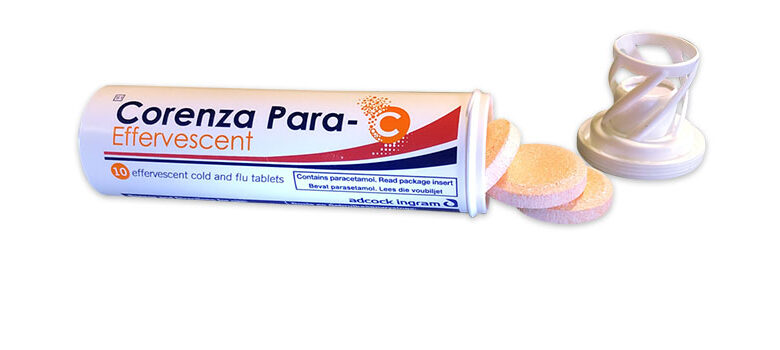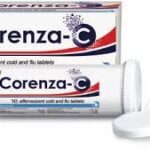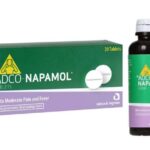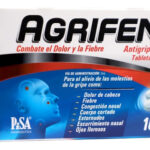Corenza Para-C: Uses, Dosage Side Effects, Pregnancy

Corenza Para-C is a cold and influenza medication containing Paracetamol 650 mg, Phenylephrine HCI 10 mg, Vitamin C 250 mg. It is designed for those who cannot take the aspirin containing Corenza C which most people with aspirin allergy cannot take.
Corenza Para-C is used for relief of mild to moderate pain, fever, nasal sinus and Eustachian tube mural congestion associated with colds and influenza. Corenza Para-C effervescent tablets have analgesic, antipyretic and decongestant actions. The combined therapeutic effect of paracetamol, the decongestant phenylephrine and vitamin C offers effective treatment for the relief of cold and flu symptoms.

How to use Corenza Para-C
Dosage and directions for use: Adults and children over 12 years: one tablet dissolved in a glass of water 3 to 4 times a day.
Storage instructions: Store below 25 degrees C. Protect from light and moisture.
Can I take Corenza Para C during pregnancy?
Do not use this Corenza Para-C while pregnant. This medication contains phenylephrine classified as pregnancy category C in all three trimesters of pregnancy. Research suggests that phenylephrine that’s taken by mouth is not safe for pregnant women. This is because of the way phenylephrine works. The drug relieves nasal congestion by narrowing the blood vessels in your nasal passages. This reduces the secretions in the nasal passages and opens up the airways. However, for oral phenylephrine, this narrowing of blood vessels is not limited to the nasal passages. It also affects the blood vessels in your uterus. Any narrowing of uterine blood vessels during pregnancy may decrease the blood flow to the fetus. And decreased blood flow can prevent the fetus from getting enough oxygen, which can cause birth defects or make the baby’s heart beat too slowly. Because of this risk, you should not take oral phenylephrine during pregnancy.
Warnings
Contraindications: Hypersensitivity to any of the ingredients. Severe liver function impairment. Patients receiving monoamine oxidase inhibitor treatment, or within 14 days of its termination. Safety in pregnancy and lactation has not been established. Do not use in children under the age of 12 years.
Do not use continuously for more than 10 days without consulting your doctor. Patients suffering from liver or kidney disease should take paracetamol containing preparations under medical supervision.
Dosages in excess of those recommended may cause severe liver damage. Should be used with caution in patients with hyperthyroidism; cardiovascular disease such as ischemic heart disease, arrhythmia or tachycardia; occlusive vascular disorders, including arteriosclerosis, hypertension or aneurysms; diabetes mellitus; closed-angle glaucoma and prostatic enlargement.
Do not use this product without consulting a doctor or pharmacist if you are presently taking monoamine oxidase inhibitors or other medicines for depression, psychiatric or emotional conditions or hypertension.
Side effects and special precautions
Paracetamol: Hematological reactions including thrombocytopenia, leucopenia, pancytopenia, neutropenia and agranulocytosis have been reported. Pancreatitis, skin rashes and other allergic reactions occur less frequently. The rash is usually erythematous or urticarial but sometimes more serious and may be accompanied by fever and mucosal lesions.
Phenylephrine: Central nervous system: fear, anxiety, restlessness, tremor, insomnia, confusion, irritability, weakness and psychotic states. Appetite may be reduced and nausea and vomiting may occur.
Cardiovascular system: vasoconstriction with resultant hypertension. The rise in blood pressure may produce cerebral hemorrhage and pulmonary edema. There may also be a reflex bradycardia, but stimulation of α1-adrenergic receptors of the heart may produce tachycardia and cardiac arrhythmias, anginal pain, palpitations and cardiac arrest. Hypotension with dizziness, fainting and flushing may occur. Anginal pain may be precipitated in patients with angina pectoris.
Other effects: may include difficulty in micturition and urinary retention, weakness, dyspnea, altered metabolism, including disturbances of glucose metabolism, sweating and hypersalivation. Headache is also common. Should be avoided or used with caution in patients undergoing anesthesia with cyclopropane, halothane or other halogenated anesthetics as they may induce ventricular fibrillation. An increased risk of arrhythmias may occur if given to patients receiving cardiac glycosides, quinidine or tricyclic antidepressants.
Known symptoms of overdosage and particulars of its treatment:
In the event of overdosage or suspected overdose and notwithstanding the fact that the person may be asymptomatic, the nearest doctor, hospital or poison control centre must be contacted immediately.
Paracetamol: Symptoms of paracetamol overdosage in the first 24 hours are pallor, nausea, vomiting, anorexia and abdominal pain. Liver damage may become apparent 12 to 48 hours after ingestion. Abnormalities of glucose metabolism and metabolic acidosis may occur. Acute renal failure with acute tubular necrosis may develop even in the absence of severe liver damage.
Cardiac arrhythmias have been reported. Symptoms during the first 2 days of acute poisoning do not reflect the potential seriousness of the overdosage. Nausea, vomiting, anorexia and abdominal pain may persist for a week or more. Liver injury may become manifest on the second day, (or later) initially by elevation of serum transaminase and lactic dehydrogenase activity, increased serum bilirubin concentration and prolongation of prothrombin time. The liver damage may progress to encephalopathy, coma and death. Cerebral edema and non-specific myocardial depression have also occurred. In the event of overdosage consult your doctor or take the patient to the nearest hospital immediately.
Specialized treatment is essential as soon as possible. Prompt treatment is essential. Any patient who has ingested 7.5 g of paracetamol in the preceding 4 hours should undergo gastric lavage.
Phenylephrlne hydrochloride: Overdosage with the phenylephrine component will result in the excessive stimulation of the central nervous system causing an increase in the severity of the CNS side effects mentioned. Treatment is symptomatic and supportive.
Vitamin C: Large doses are reported to cause diarrhea and other gastrointestinal disturbances, hyperoxaluria and tolerance may be induced. Large doses can also cause formation of kidney stones. Treatment is symptomatic and supportive. Keep out of reach of children. Do not use for more 10 days without consulting your doctor.





